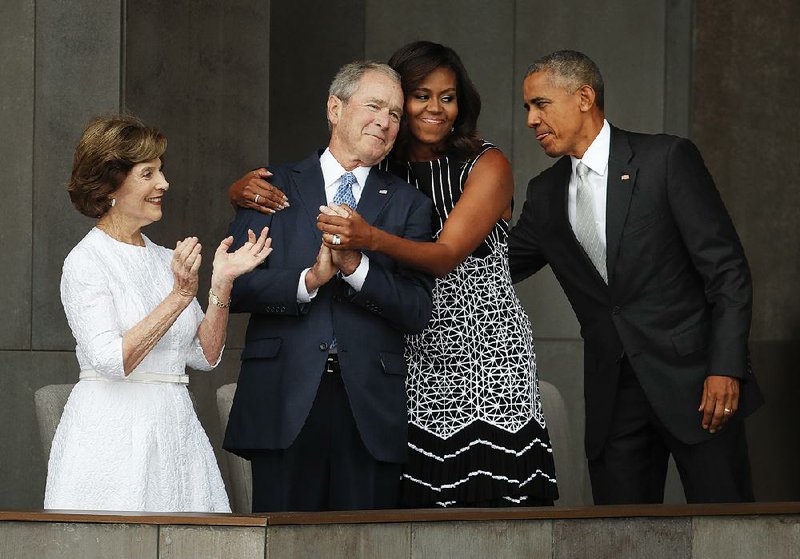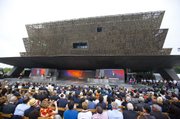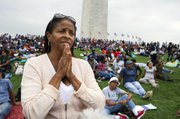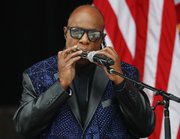WASHINGTON -- In a speech filled with reminders of America's dark and not-so-distant past, as well as hopes for a brighter future, President Barack Obama helped to inaugurate the National Museum of African American History and Culture on Saturday in Washington.
The country's first black president stood before more than 7,000 official guests -- and thousands more gathered on the National Mall -- and repeated the words of poet Langston Hughes: "I, too, am America."
"African-American history is not somehow separate than the American story. It is not the underside of the American story. It is central to the American story," Obama said.
Behind him, the 400,000-square-foot museum stood as a testament to that. Serving as home to more than 36,000 artifacts, the museum exists to memorialize and educate, sharing the truth of America's past and celebrating the triumphs of its present.
"It helps us better understand the lives, yes, of the president, but also the slave, the industrialist but also the porter, the keeper of the status quo but also the activist seeking to overthrow that status quo, the teacher or the cook alongside the statesmen," Obama said. "By knowing this other story, we better understand ourselves and each other."
He and first lady Michelle Obama joined Ruth Bonner, a 99-year-old direct descendent of a slave, and her family as they rang a bell from the historic First Baptist Church of Williamsburg, Va., to signal that the museum was officially open.
The church, believed to be among the first Baptist churches organized entirely by black people, acquired its Freedom Bell in 1886. The bell will return to the church for the church's 240th anniversary later this year.
Saturday's long-awaited opening was being heralded with a weekend of celebrations across the city, in what the museum Director Lonnie Bunch has called a "mini-inauguration." The most anticipated event was the opening ceremony, which included speeches from Oprah Winfrey, Will Smith, Supreme Court Chief Justice John Roberts and former President George W. Bush, who signed the 2003 bill that authorized the museum.
Bush called the finished product "fabulous," saying: "It shows our commitment to truth. A great nation does not hide its history. It faces its flaws and corrects them."
The museum, Bush said, celebrates several of his heroes, including musician Chuck Berry, baseball player Willie Mays, and Supreme Court Justice Thurgood Marshall.
He gave credit to Rep. John Lewis, D-Ga., who spent 15 years fighting in Congress to make the museum a reality. When he took the stage Saturday, Lewis had to take long pauses to contain his emotion.
"There were some who said it couldn't happen, who said 'you can't do it,' but we did it," said Lewis. "This place is more than a building. It is a dream come true."
The building itself is striking: Its bronze-hued exterior and unusual shape stand starkly in contrast with the buildings surrounding it, and purposefully so. Inside, visitors walk the path from slavery to civil rights to the Black Lives Matter movement, and everything in between. The familiar and the untold stories of history are shared through meaningful objects, such as the shawl of Harriet Tubman, a candy-red Cadillac driven by Berry, and the uneven-bar grips used by Gabby Douglas in the 2012 Olympics.
Museum officials say the exhibits include a Tuskegee Airmen training plane and the casket of Emmett Till, a 14-year-old black boy whose 1955 murder helped rally the civil-rights movement.
Millions of donors, known and unknown, contributed to the $315 million in private funding raised before the museum's opening. Some of the biggest donors' names adorn the walls inside, including the Oprah Winfrey Theater; the Michael Jordan Hall: Game Changers; and the Robert F. Smith Explore Your Family History Center -- named for the chief executive officer of investment firm Vista Equity Partners after a $20 million gift announced Monday.
For the time being, getting inside the museum will take some planning. Although, as with all Smithsonian museums, entry is free, admission requires a timed ticket, available at nmaahc.si.edu/visit/passes. All of the tickets for opening weekend were snapped up right after they were made available in August. Tickets for September, October, November and every weekend in December are sold out. But starting Monday, individuals can obtain up to four same-day passes from the visitor services staff starting at 9:15 a.m.
Even for those without a ticket, there were events planned for the National Mall over the weekend: On the Washington Monument grounds between 15th and 17th streets, the museum was hosting a free, three-day festival celebrating black culture. Food stands were to offer Southern barbecue, Kenyan curries, Caribbean jerk and Gulf Coast po' boys. Music, poetry, dancing and storytelling entertained visitors throughout the day, leading to a Saturday night concert featuring Living Colour, Public Enemy and The Roots. The festival continues today.
People were already streaming onto the grounds of the Washington Monument before sunrise Saturday, hoping to get a view of the festivities -- or at least see them on the Jumbotrons nearby.
"We are very excited to see our family history," said Gladys Atkins, from Helmetta, N.J. "We, of course, descended from slaves. ... I have photographs of my slave ancestors."
She and her husband had tickets to enter the museum at 5:30 p.m. Saturday. In fact, they had tickets for four separate days.
"We are serious," she said.
Attendees looking up at the National Mall's newest landmark wondered aloud about what its existence means to the conversation about race in America. The opening ceremony came at the end of a week during which two deadly police shootings -- of Keith Lamont Scott in Charlotte, N.C., and Terence Crutcher in Tulsa -- became the latest catalysts for ongoing protests about the way black men are treated by law enforcement officers.
"I can only hope that this [museum] does provide an opportunity for greater healing," said Atiba Muse, a political organizer from Petersburg, Va., who sat among other donors at the ceremony. "We're in need of triage. This is the initial steps to resuscitate."
Obama weighed in on the museum's significance in light of recent events.
"Hopefully, this museum can help us talk to each other, and more importantly listen to each other, and most importantly, see each other," he said.
"Perhaps [the exhibits] can help a white visitor understand the pain and anger of a demonstrator in Ferguson and Charlotte," Obama said, referring to Ferguson, Mo., where the slaying of a black man at the hands of police in 2014 spurred protests there and across the country.
Perhaps, he said, the museum can help a black visitor see the efforts of police officers who, "in fits and starts, are struggling to understand and trying to do the right thing."
Others were overwhelmed thinking of how far the black community has come. Beulah Stowe Cary, 92, sat outside the ceremony in a motorized wheelchair, telling the story of her childhood. She was born in North Carolina in 1924 but remained in the state for just three weeks before her family sent her to relatives in Virginia. She had a white mother and a black father; they feared that a biracial baby wouldn't be safe in the South.
David Hudson, a volunteer from Silver Spring, S.C., recalled being chased out of a restaurant in South Carolina because he is black. He was 8 years old at the time.
Hudson, now 63, spent the day passing out programs at the foot of a building erected to ensure that his country will never forget how people like him were treated.
"I am overwhelmed. I'm humbled," said Deborah Elam, president of the GE Foundation and chief diversity officer for General Electric, as she waited Saturday among the dignitaries on the National Mall. GE donated $5 million toward the museum's construction.
"It's like walking across the desert and finally getting to a fountain of water to quench your thirst," said Verna Eggleston, 61, of New York City, who was touring the museum later Saturday. "It's absolutely breathtaking for me."
Information for this article was contributed by Jessica Contrera, Ellen McCarthy, Peggy McGlone, Michael Ruane and Krissah Thompson of The Washington Post; by Jesse J. Holland and Darlene Superville of The Associated Press; and by Mark Landler and Noah Weiland of The New York Times.
A Section on 09/25/2016



